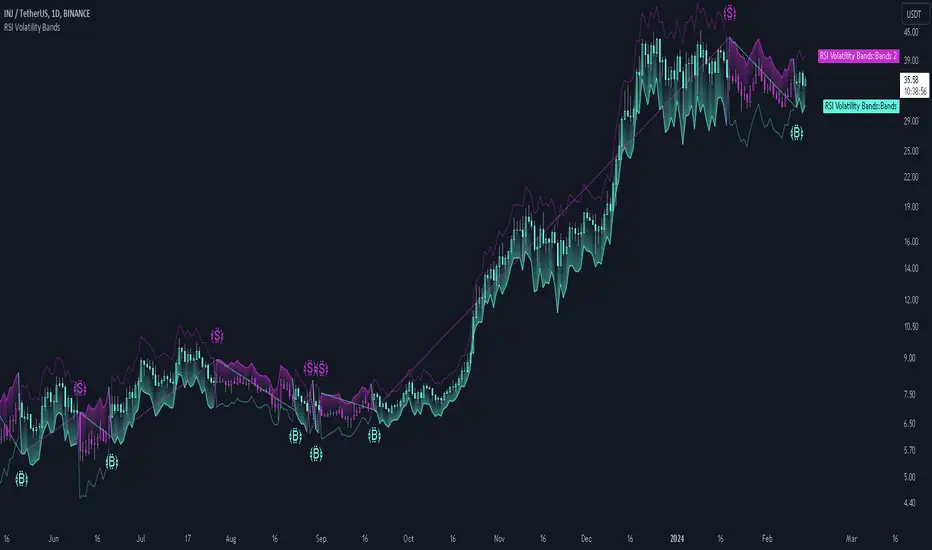OPEN-SOURCE SCRIPT
已更新 RSI Volatility Bands [QuantraSystems]

RSI Volatility Bands
Introduction
The RSI Volatility Bands indicator introduces a unique approach to market analysis by combining the traditional Relative Strength Index (RSI) with dynamic, volatility adjusted deviation bands. It is designed to provide a highly customizable method of trend analysis, enabling investors to analyze potential entry and exit points in a new and profound way.
The deviation bands are calculated and drawn in a manner which allows investors to view them as areas of dynamic support and resistance.

Legend

Case Study
Recommended Settings
The RSI Volatility Bands are highly customisable and can be adapted to many assets with diverse behaviors.
The calibrations used in the above screenshots are as follows:
Methodology
[list = 1]
*The indicator first calculates the RSI of the price data, and applies a custom moving average.
*The deviation bands are then calculated based upon the absolute difference between the RSI and its moving average - providing a unique volatility insight.
*The deviation bands are then adjusted with another smoothing function, providing clear visuals of the RSI’s trend within a volatility-adjusted context.
Pine Script®
By dynamically adjusting to market conditions, the RSI trend bands offer a unique perspective on market trends, and reversal zones.
Introduction
The RSI Volatility Bands indicator introduces a unique approach to market analysis by combining the traditional Relative Strength Index (RSI) with dynamic, volatility adjusted deviation bands. It is designed to provide a highly customizable method of trend analysis, enabling investors to analyze potential entry and exit points in a new and profound way.
The deviation bands are calculated and drawn in a manner which allows investors to view them as areas of dynamic support and resistance.
Legend
- Upper and Lower Bands - A dynamic plot of the volatility-adjusted range around the current price.
- Signals - Generated when the RSI volatility bands indicate a trend shift.
Case Study
- The chart highlights the occurrence of false signals, emphasizing the need for caution when the bands are contracted and market volatility is low.
- Juxtaposing this, during volatile market phases as shown, the indicator can effectively adapt to strong trends. This keeps an investor in a position even through a minor drawdown in order to exploit the entire price movement.
Recommended Settings
The RSI Volatility Bands are highly customisable and can be adapted to many assets with diverse behaviors.
The calibrations used in the above screenshots are as follows:
- Source = close
- RSI Length = 8
- RSI Smoothing MA = DEMA
- Bandwidth Type = DEMA
- Bandwidth Length = 24
- Bandwidth Smooth = 25
Methodology
[list = 1]
*The indicator first calculates the RSI of the price data, and applies a custom moving average.
*The deviation bands are then calculated based upon the absolute difference between the RSI and its moving average - providing a unique volatility insight.
*The deviation bands are then adjusted with another smoothing function, providing clear visuals of the RSI’s trend within a volatility-adjusted context.
rsiVal = ta.rsi(close, rsiLength)
rsiEma = ma(rsiMA, rsiVal, bandLength)
bandwidth = ma(bandMA, math.abs(rsiVal - rsiEma), bandLength)
upperBand = ma(bandMA, rsiEma + bandwidth, smooth)
lowerBand = ma(bandMA, rsiEma - bandwidth, smooth)
long = upperBand > 50 and not (lowerBand < lowerBand[1] and lowerBand < 50)
short= not (upperBand > 50 and not (lowerBand < lowerBand[1] and lowerBand < 50))
By dynamically adjusting to market conditions, the RSI trend bands offer a unique perspective on market trends, and reversal zones.
發行說明
Fixed a bug when using the customized color palette.發行說明
Added the option to hide the volatility band fill effect and the signals.發行說明
Added 'Dynamic' capabilities.發行說明
Updated Dynamic Function Library.Updated header name tag.
發行說明
Updated License.License formatting shout out to RUBIX_BINARY
開源腳本
本著TradingView的真正精神,此腳本的創建者將其開源,以便交易者可以查看和驗證其功能。向作者致敬!雖然您可以免費使用它,但請記住,重新發佈程式碼必須遵守我們的網站規則。
No statements or claims aim to be financial advice,
neither are any signals from us or our indicators.
Want to learn Trading, Investing or system building?
Join the Community! 👇
discord.gg/FMZDM3bZ9T
neither are any signals from us or our indicators.
Want to learn Trading, Investing or system building?
Join the Community! 👇
discord.gg/FMZDM3bZ9T
免責聲明
這些資訊和出版物並不意味著也不構成TradingView提供或認可的金融、投資、交易或其他類型的意見或建議。請在使用條款閱讀更多資訊。
開源腳本
本著TradingView的真正精神,此腳本的創建者將其開源,以便交易者可以查看和驗證其功能。向作者致敬!雖然您可以免費使用它,但請記住,重新發佈程式碼必須遵守我們的網站規則。
No statements or claims aim to be financial advice,
neither are any signals from us or our indicators.
Want to learn Trading, Investing or system building?
Join the Community! 👇
discord.gg/FMZDM3bZ9T
neither are any signals from us or our indicators.
Want to learn Trading, Investing or system building?
Join the Community! 👇
discord.gg/FMZDM3bZ9T
免責聲明
這些資訊和出版物並不意味著也不構成TradingView提供或認可的金融、投資、交易或其他類型的意見或建議。請在使用條款閱讀更多資訊。